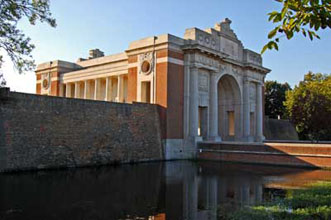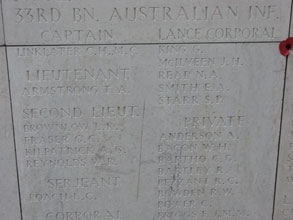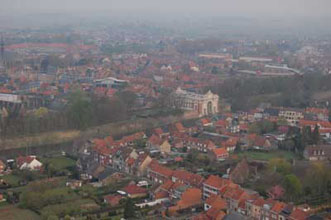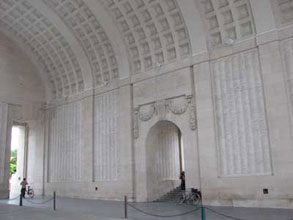Document 18 - “He is not missing, he is here”
Article on the Menin Gate
For most of the war, the Belgian town of Ypres stood just behind the British front lines. Many thousands of British and Empire troops marched through it on their way out to the battlefields. Many went through the Menin Gate- a gap in the town's medieval wall leading directly to the front.
This gate's location and its association with the many thousands of soldiers who fought around Ypres, made it a symbolically powerful place. The British government decided to construct a major memorial to missing soldiers there after the war. Its construction began in 1921.
The Menin Gate memorial was designed to commemorate soldiers who had no known grave in the many cemeteries dotting the countryside around Ypres. Its walls were inscribed with each soldier's name- 54,898 in all. 6,198 of these were missing Australian men.
The gate faces the old battlefields. One plaque dedicates the structure “to the armies of the British Empire who stood here from 1914 to 1918 and to those of their dead who have no known grave.” Another plaque explains to visitors “here are recorded names of officers and men who fell in Ypres Salient but to whom the fortune of war denied the known and honoured burial given to their comrades in death”.
The British poet Siegfried Sassoon, an outspoken critic of the war, used fewer euphemisms as he described the memorial bitterly in his poem, On passing the new Menin Gate:
Here was the world's worst wound. And here with pride
‘Their name liveth for ever,’ the Gateway claims.
Was ever an immolation so belied
As these intolerably nameless names?
Well might the Dead who struggled in the slime
Rise and deride this sepulchre of crime.
The Menin Gate was inaugurated on 24 July 1927. Hundreds of ex soldiers and relatives attended the opening ceremony. During the ceremony, British Army buglers played ‘The Last Post’, a tradition which has been maintained each night to this day.
Field Marshal Herbert Plumer - the British General who commanded at the Battle of Messines in 1917 - spoke about the Gate's significance at the unveiling ceremony.
One of the most tragic features of the Great War was the number of casualties reported as "missing, believed killed". When peace came, and the last ray of hope had been extinguished, the void seemed deeper and the outlook more forlorn for those who had no grave to visit, no place where they could lay tokens of loving remembrance. And it was resolved that here at Ypres, where so many of the missing are known to have fallen, there should be erected a memorial worthy of them which should give expression to the nation's gratitude for their sacrifice and their sympathy with those who mourned them. A memorial has been erected which, in its simple grandeur, fulfils this object, and now it can be said of each one in whose honour we are assembled here today: 'He is not missing; he is here'.




Ask Yourself
- What are the similarities and differences between Plumer and Sassoon's descriptions of the Menin Gate?
- What significance did the Menin Gate have to families of missing soldiers in 1927?
- How might the gate's significance have changed today?
